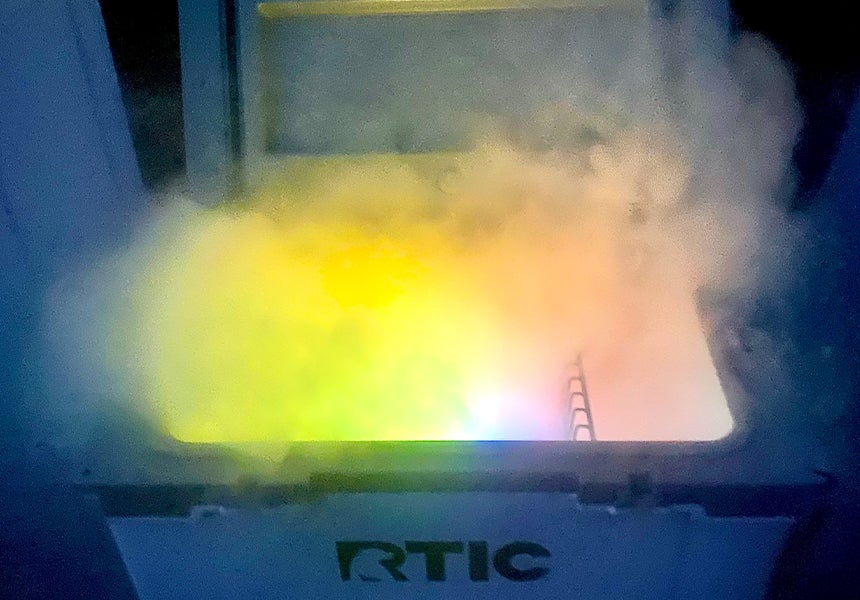
Our Editors independently research, test, and rate what we feel are the best products. We use affiliate links and may receive a small commission on purchases.
How does the old joke go? Fish and houseguests – both start to stink after a few days? Getting things that stink to go away can be a harrowing journey, especially when you start thinking about your cooler. There isn’t much that is worse, too. You plunk down a bunch of money for a fancy cooler, only to have it get a funky smell that just won’t go away. You go to grab a sandwich or a cold one and – whiff – the next thing you know, you’re reminded of that road-kill raccoon that has been sitting alongside the road for a few weeks, baking in the sun. Talk about a mood killer! No fear, cleaning tips are here! We rounded up the experts to get some first-hand knowledge regarding how to clean a smelly cooler.
Cover image by Derrek Sigler
Ever forget? Happened to me.
One of the worst things that can happen to you and your cooler is to forget that something is in there. Instant smelly cooler. I have a beautiful and pricey 100-quart cooler – one of those fancy roto-molded jobs, too. This thing is amazing. I once filled it with ice and set a bunch of drinks in it, and a full week later, there was still ice in the cooler. Being big, it’s really handy, too. Like the time I used it to help while we cleaned out the freezer. I was able to get everything we had shoved into the freezer into the cooler, and everything stayed frozen while we cleaned the freezer that had gotten nasty when our daughter spilled a tray of ice cubes that she had filled with Kool-Aid instead of water. I was able to get everything back into the freezer after a few hours. All except that rack of ribs I decided to keep out and cook later. We were going to clean out the fridge side, too, so I figured I’d just wait and put the ribs into the fridge side when I put all that stuff back. Then we didn’t clean out the fridge. And then… My son put the cooler away in the garage.
Two months went by and we went to grab the cooler to use for a camping trip. By now, the rack of ribs had turned into some form of alien sludge monster from the planet Stank. My wife popped open the lid of the cooler, and I do mean “popped” as in – it was pressured from the decayed nastiness contained within. As my father-in-law aptly said, “Whoa, that stink would knock a buzzard off a gut pile!”
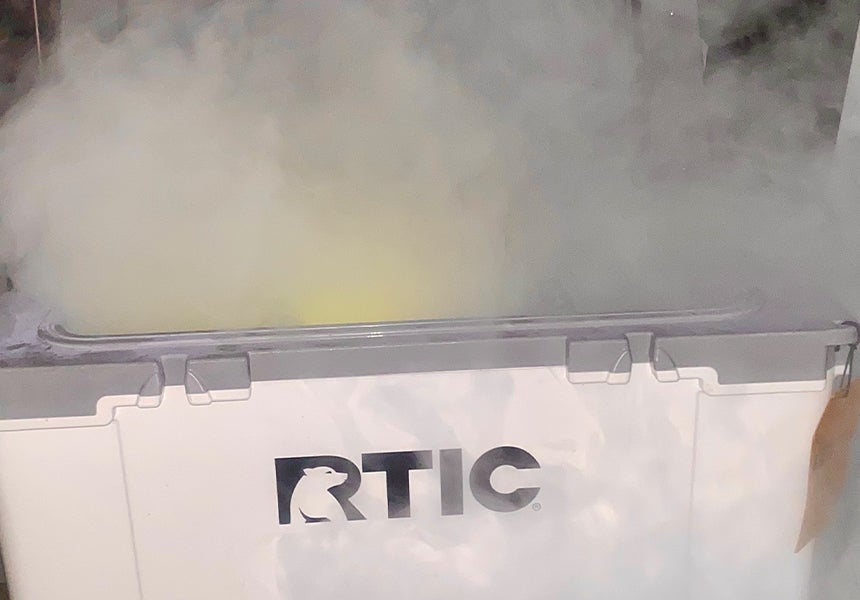
After I donned full haz-mat gear and banished the offending content of the smelly cooler, the real journey of discovery began. How do I get the “stank” odor out of the cooler so it would be usable again? That was the $475 question, which is how much it would cost to replace the cooler. Trust me when I say that that option topped the list for some time. Follow along on this tale of woe to see what worked to take the stank out of the cooler.
What the experts say about smelly coolers
Luckily for me, I have access to some of the top people in the outdoor industry, so I was able to talk to them about my issues. It seems that I am not alone in dealing with the funky stench of a stinky cooler.
Steve Whitworth, Director of Product at RTIC Outdoors, gave me some advice that really helped clean a smelly cooler, and yes, this worked in banishing the foul odors. He had two options, and the first and natural one worked very well. But I will add – This was not my first attempt at exorcizing the demon smell from the cooler. I tried several other things first.
“For a natural and fresh solution, wash your cooler with a mix of warm water and approximately 25-percent lemon juice,” Whitworth said. “If that doesn’t get it all, wipe down the sides and lid with lemon halves and follow with another wash of dish soap (Dawn Powerwash works well) and warm water. Dry completely with a clean towel.”
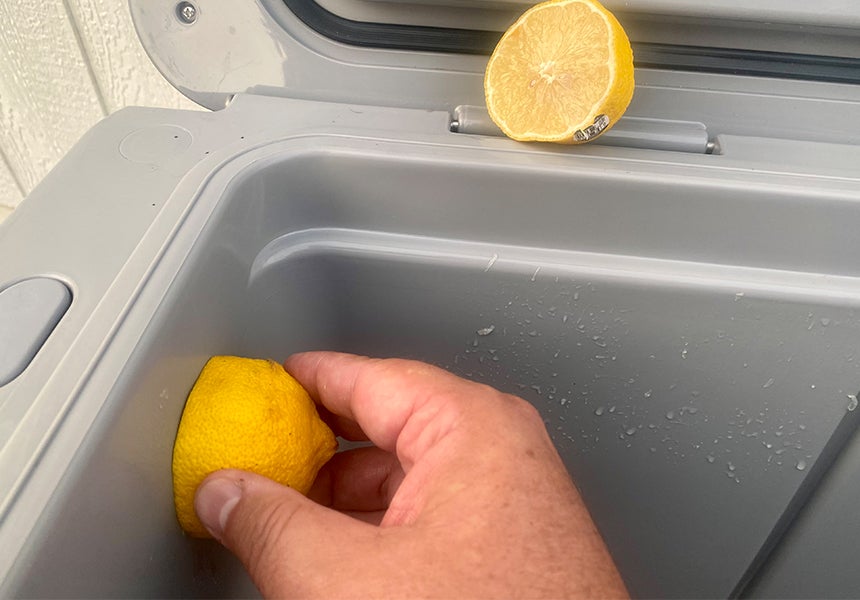
Photo by Derrek Sigler
This worked. I had tried just washing the smelly cooler a few times, but no matter what, the foul odor persisted like that last party guest that won’t take the hint and leave. Mind you, the cooler in question wasn’t even an RTIC product, although I do have one of their sweet 52-quart Ultralight coolers. The citric acid in the lemon worked better than anything I had tried.
Someone also suggested leaving baking soda in it, but that didn’t do anything really. That does work for soft coolers, which we’ll get to in just a moment. But leaving an open box of baking soda in the cooler and leaving it be did not work at all. That might help make your fridge smell a little better when you leave your mother-in-law’s leftover meatloaf a little longer than you should because no one wanted to eat it – even the dog – but it didn’t take down the demons living in my cooler.
Whitworth suggested something else that I was going to try next if the lemons failed.
“Try wiping the interior with a cloth saturated with vanilla extract,” he said. “Then I would leave the cloth in the cooler overnight.”
This sounds like a good idea and something to try. Vanilla extract has a strong odor, but it is very mild and pleasing to most people. It is actually a scent neutralizer, too. I had to look into it and try it out for myself. I know from past experience that if you add some to boiling water and then turn off the heat, it will knock down pet smells in your home. I have a 100lb. Newfoundland that likes to swim in my stale pond and then trot back into the house. I know a thing or two about stale damp pet odor. I see no reason why using vanilla extract to rid your cooler of smells wouldn’t work great.
Going nuclear on a smelly cooler
One of the things that was suggested was trying bleach. In fact, Whitworth also suggested trying this as an option for the smelly cooler. He suggested a diluted solution of chlorine bleach and water at a 6:1 ratio as a great option. Bleach is a tough one for me. While I actually do appreciate the clean smell of chlorine, I also have a tough time with too much of it.
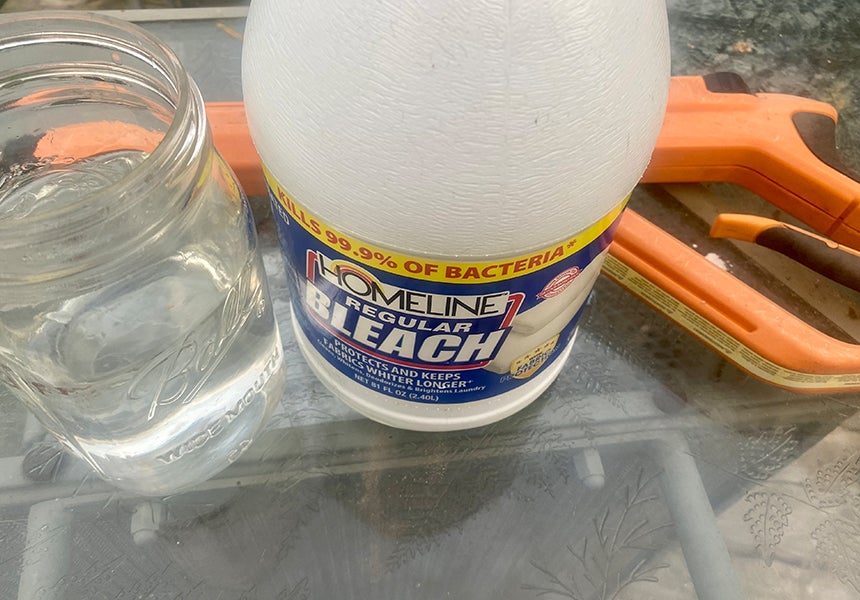
Photo by Derrek Sigler
Tyler Berg, speaking on behalf of the fine folks at Yeti coolers echoes the sentiment about bleach.
“For cleaning YETI’s Tundra coolers, soap and water typically works well – but if you have tough stains and strong odors, you should use a mixture of water and bleach (6:1 ratio) and scrub it down with a brush,” Berg said. “A high-pressure sprayer should also clean stains really well.”
Forgetting something and finding a problem is something Berg has some expertise in, too. He created one in his own Tundra cooler, and had to work it out with some elbow grease.
“This past winter, I used my Tundra to rest a brisket I smoked,” Berg said. “I forgot to remove the towel I had wrapped around the brisket and tinfoil. Opened it up, months later and found a ton of mold. I just used the bleach and water method and I didn’t have any lingering stains or smell. A good soak and spray down with a garden hose did the trick.”
Here’s the kicker for me. I tried the bleach mixture with the smelly cooler and it didn’t work. I fully cleaned the thing with a bleach solution and let it dry. Sure enough, there was the same funky smell from decomposed spare ribs. I likely could have used a stronger bleach solution, but I just could not bring myself to do it.
What I think was the issue, and this is something I have been looking into more, is that each company uses different proprietary plastics for the shells of their coolers. Some of these plastic composites are more porous than others on a microscopic scale. Polypropylene is a common plastic that is part of the make-up of several coolers, and, by itself, is porous and will absorb scent. If you think of your mom’s old Tupperware, that stuff takes on an odor after a while because of the polypropylene it is made from. That material is common in cooler construction, but not all poly materials are equal. I have had no issues cleaning stains and stank out of the Yeti, RTIC and Pelican coolers I own. And yes, I am bragging a little that I own several high-end coolers. Some people have fancy cars, I apparently have coolers.
Don’t blow a gasket, dude!
One thing that is very important – Don’t forget the gasket. Most every modern roto-molded cooler has some form of rubber gasket that is used to seal the interior of the cooler. Unless it is glued into the cooler, and it might be depending upon which brand you own, the gasket can be removed and cleaned or replaced.
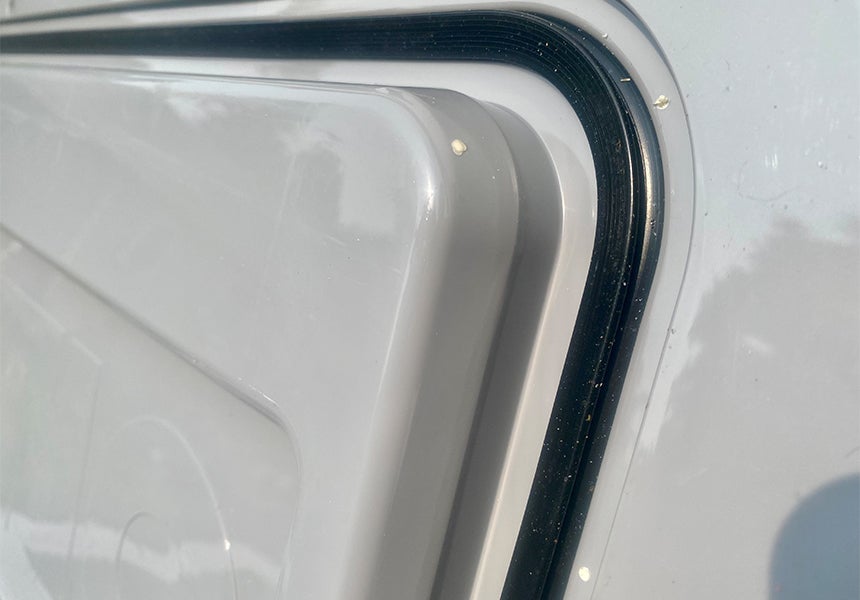
Photo by Derrek Sigler
One cooler brand, which asked me to not mention them by name, suggested that you should replace the gasket if the bad odor persists because it may not be able to be removed from the gasket. Replacing the gasket really isn’t that hard and if you were dumb like me and left something in the cooler that goes bad and makes you consider burning the cooler to get rid of the odor, might be worth it to try replacing the gasket first. Just saying.
Storing a hard cooler
I should point this out. You should never, ever store your cooler completely sealed up. When your cooler is just sitting there waiting for you to fill it up and go out on an adventure again, either flip the rubber latches back into the cooler, keeping the lid cracked open, or take out all the drain plugs and keep them inside the cooler.
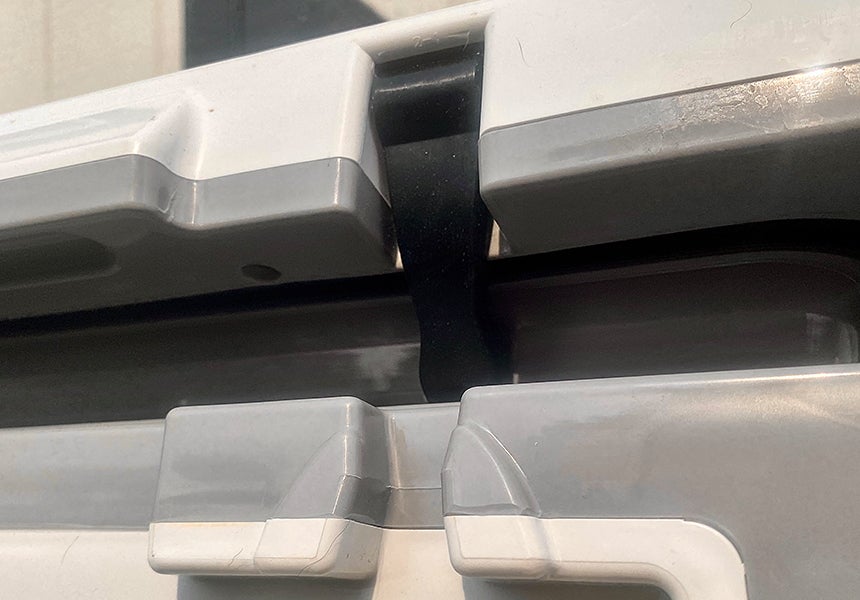
Photo by Derrek Sigler
Air is your friend while storing the cooler. If you seal that sucker shut and leave it in the corner of the garage for 6 months, don’t blame me if the inside smells like your great-grandmother’s closet. I tried to tell you not to do that so you would avoid the mildewy-musty odor.
Funky soft coolers
Soft coolers are a really handy way to carry your cold stuff and keep it cold without the bulk of a hard-sided cooler. I’ve used a bunch of soft-sided coolers over the past few years and have come to truly appreciate the convenience of them. Don’t worry, I have a horror story for these, too. It all started with a spring fishing trip for walleye and a buddy. He took his brand-new soft cooler that his wife had just bought for summer travels. The fishing was great, and he brought home a bunch of fish for the freezer. He pulled the fish out of the cooler, got them all cleaned out and packaged up and then decided to kick back and relax. At this point in the story I will interject that his wife likes to remind him that he decided he needed to relax after a long day or fishing. Notice I said nothing about him washing out the expensive soft-sided cooler his wife had just bought for their summer travels?

Photo by Yeti Outdoors
Something smells fishy
How do you get fish smells out of a cooler? Good question. I’m glad you asked because I got to help my friend solve that very dilemma. Luckily for me, Mr. Whitworth at RTIC had some suggestions that worked great.
“Use a simple paste made of baking soda and warm water to gently scrub the interior,” Whitworth said. “Follow with a wash using warm soapy water and a complete rinse to get it clean. Towel dry and prop it open overnight to fully dry.”
Baking soda might not have been the hot ticket for the hard cooler, but it works like a charm on the soft-sided smelly coolers. The reason, I suspect, is that the materials are completely different, and the plastics that go into a soft-cooler liner are more porous than the injection-molded plastics of a hard cooler.
“For any lingering smells, we suggest putting a cup or two of dry baking soda into a wide bowl and letting it sit inside the closed cooler for a day or two,” Whitworth said. “Follow that by it washing again with warm soapy water and dry the interior of the cooler out fully.”
This tactic for getting the fish smell out of a cooler saved my buddy a lot of money, as he would have likely needed to replace the cooler. As it was, you’d never know he left walleye slime sitting in the cooler for a day. And now he knows what to do next time so he won’t have to apologize to his wife, or ask me for help. It cost him plenty to not have me use his name and picture in this story.
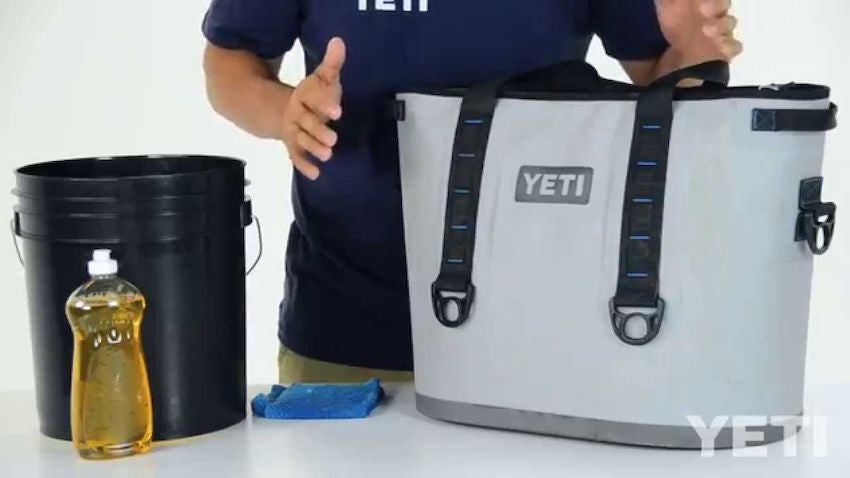
Photo by Yeti Outdoors
Berg and Yeti, who make some amazing soft-sided coolers, have similar suggestions for cleaning and smell removal.
“For soft coolers, like the Hopper Flips or Hopper M30/M20s, we recommend using a mixture of dish soap and water, but make sure to thoroughly wipe it dry with paper towel or an old rag,” Berg said. “It is also important to leave the zipper open for several days to make sure all the moisture dries. You’ll also want to use the HydroLok Zipper lube included with all soft coolers, to make sure the zipper stays in good shape.”
Taking care of the zipper is very important for the longevity of your cooler and is an important step in making sure you avoid the dreaded smelly cooler syndrome.
Thermal cups
I’m not going to lie. I have an obscene amount of thermal cups, including Yeti Ramblers, RTIC Tumblers, Pelican cups and a pile of other brands. I drink a lot of coffee and tea, and lemonade and iced tea in the summertime. These cups are basically coolers in their own right, being two layers of stainless steel that has a vacuum space between the layers and an internal lining of copper. Copper is a natural conductor, and it helps keep hot things hot, and cold things cold.
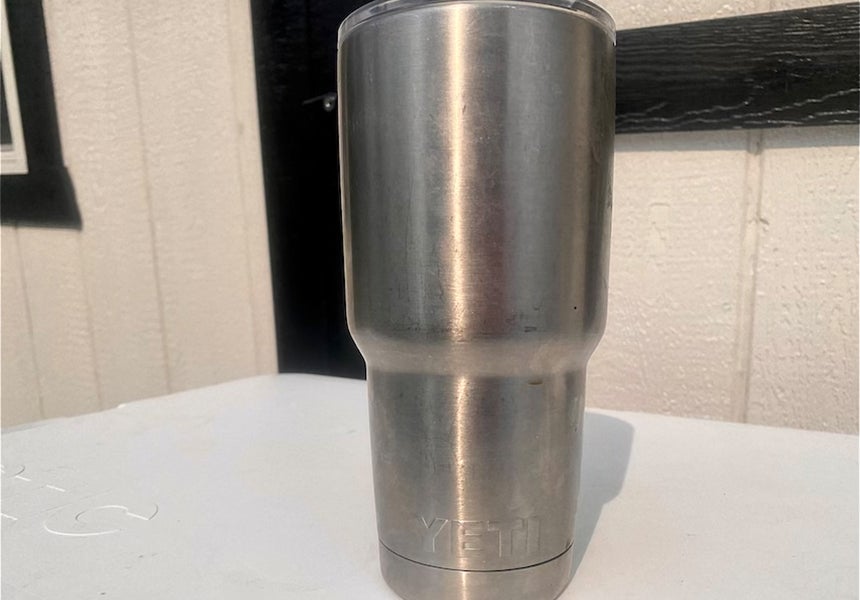
Photo by Derrek Sigler
Keeping the cups themself free of bad odors is extremely easy, and believe me when I say that I’ve done some things with these cups that I’m not proud of. Like the time I was headed to the airport for a flight out to a week-long summer event. I had numerous phone calls on the way to the airport, so I barely got but a few sips of my precious morning caffeine-infused mood stabilizer. A mostly full, 30oz. Yeti Rambler sat baking in my truck at the airport parking lot in the heat of August. The heat transformed my mixture of coffee, milk and sugar into a smelly souffle that resembled bean curd in the shape of the cup when I dumped it out, but smelled like a cross of curdled milk and old, sweaty, fat guy belly-button lint (And being an old, sweaty, fat guy, I can make that joke and not offend). Cleaning the cup is the easy part.
“As far as tumblers and bottles go, you can typically clean them with a dishwasher – every part is dishwasher safe,” Berg said about cleaning a Yeti cup. “Hand washing them with mild dish soap also works. If it’s REALLY gnarly with tough stains, we recommend our deep-cleaning tablets. You just drop one in and let it sit for five minutes before pouring out and rinsing. You should also run it through the dishwasher after.”

Photo by Derrek Sigler
The biggest challenge with any of these cups is remembering to clean the gasket for the lid. I was blissfully unaware of the gasket until a friend and fellow editor, Hilary Dyer from another publication, pointed it out. She, too, is a Yeti cup aficionado, and she HAD to post on social media that she cleaned her lid’s gasket. Sure enough, I check my cup and realized that I should also clean out the gunk that had built up there.
And yes, there was a funky smell associated with said gasket gunk. I will spare you the description, but if you haven’t cleaned your gasket in a while, I suggest doing so. All of these types of cups have one, and all of them need to be cleaned out regularly. If need be, replace it if it is just too much to deal with.
A cool tip about stainless steel and odors
Stainless steel is a compound of iron and other metals that give the steel its properties. The compounds cause the steel to have a surface that resists staining and rust. It makes them very easy to clean, as there are no pores within the surface of the metal, so cleaning your stainless steel cup is easy. It goes a little deeper, too, according to Dr. Anne Marie Helmenstine. She said that stainless steel’s compounds actually bind with odor and remove it from your hands, but the surface of the metal doesn’t absorb the odor. It actually comes right off during cleaning.
You can actually remove bad odors from your hands by rubbing a stainless steel item, like your Yeti Rambler, or something similar. Got some funky fish odor on your hands, rub your Rambler and it’ll go away. I’d wipe the slime off first, or use your buddy’s cup instead… SCIENCE!
Charcoal?
Similar to baking soda, activated charcoal is a powerful odor absorber. After cleaning and drying the cooler, place a pouch or bowl of activated charcoal inside, close the lid, and let it sit for several days.
How to Clean a Smelly Cooler FAQ
Q: Why does my cooler stink?
A: The quick and easy answer to the likely cause of a bad smell in your cooler is mildew. Leaving a cooler completely closed, whether it is a soft cooler bag, or a hard-sided cooler, invites mildew growth, even if you are sure you completely dried the cooler before you put it away. The air alone has moisture in it, and that can lead to a funk in your cooler that will leave you unhappy and needing to clean it.
Q: Why does my cooler smell like fish?
A: Most fish smell actually comes from the slimy residue they secrete that covers their skin. For the fish, this is an antibiotic layer that protects their skin and keeps them from developing infections, as well as help them swim. The bad thing is, it comes off on any surface it comes in contact with. So when you put your catch into your cooler, things are going to get slimy in a hurry. Always clean your cooler fully using one of the techniques listed in this story to avoid it smelling putrid.
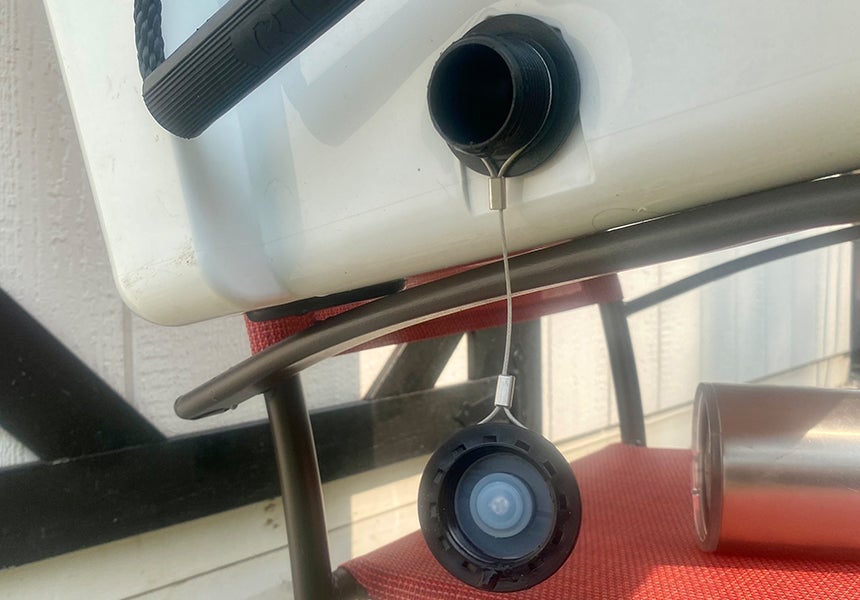
Photo by Derrek Sigler
Editor’s Note: No coolers were harmed during the writing of this article. Well, maybe a little…
